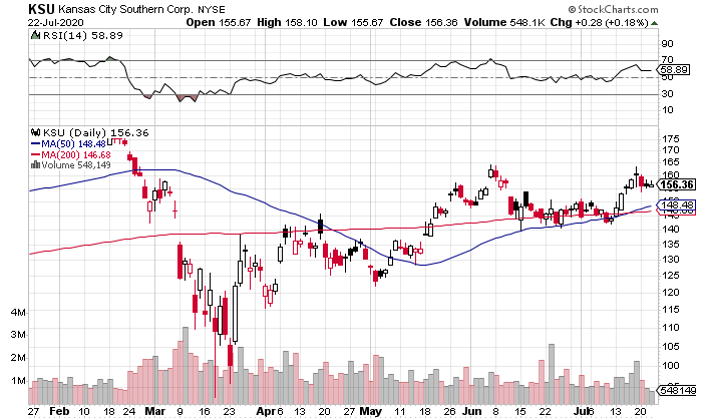Kansas City Southern NYSE: KSU, for those that aren’t familiar, is a rail transportation services company that serves the chemical and petroleum, industrial and consumer products, agriculture and minerals, energy, intermodal, and automotive markets.
KSU is coming off a quarter where revenue dropped 23% on a 21% decline in volumes.
So, why should you pay attention to a company in a boring industry coming off a tough quarter?
Kansas City Southern saw its volumes plummet in April and May due to the coronavirus. But carloads have quickly recovered and are now approaching pre-pandemic levels. On top of that, the company got more efficient during the slowdown – cutting costs. And a lot of these cost-cutting measures appear to be sustainable as revenue recovers.
Let’s dig into the numbers.
Kansas City Southern - A V-Shaped Recovery
Just before the pandemic hit, KSU was tracking at around 6,200 carloads per day. That number hit a low of just over 4,000 per day in early May. But by late June, Kansas City Southern was averaging nearly 6,000 carloads per day, a 39% recovery from the lows of less than two months prior.
It was an unprecedented period for the company.
On the Q2 2020 earnings call, CEO Patrick J. Ottensmeyer said, “I don't think anyone on this call has ever seen a 90-day period where business levels dropped so quickly, stayed at a stable level for a relatively short period of time and then recovered and responded so quickly thereafter.”
How Much Was Kansas City Southern Able to Cut Costs?
Kansas City Southern took the pandemic-related slowdown as an opportunity to make its operations more efficient.
For example, train starts were down around 40% at the carload lows. But now they are still down 25% even though traffic is only down 6% from pre-pandemic levels.
KSU expects to soon match pre-pandemic volumes, but to do so with “20% less train starts, 20% less crew starts, 20% less locomotives, 20% higher train lengths, and 9% better fuel efficiency than we did in February.”
On the call, Executive VP Sameh Fahmy translated the efficiency gains into cost savings:
“All these things translate into money at the end of the day. And when you look at the transportation operating expense, it went down by about 27%. The crews, the active crew count in the US went down from 1,346 to 1,050. And again, we are only 6% below the volumes that we had in February. The mechanical costs went down by 29%. The mechanical staffing is down 14% from what it was June last year. Engineering also chipped in with about 9% improvement.”
The company is still expecting at least $500 million in free cash flow in 2020, which gives KSU a big cushion should business take an unexpected turn for the worse.
KSU is currently trading at around 27x TTM earnings. At first glance, that multiple looks a bit steep for a company that is likely to see single-digit annualized revenue growth going forward. But when you factor in the new (and seemingly sustainable) cost-cutting measures, the valuation looks more reasonable.
Kansas City Southern - An Emerging Up-Trend
KSU shares plummeted at the onset of the coronavirus pandemic, losing nearly half their value between mid-February and mid-March. Many stocks declined by the same amount (or more), but the move was surprising for a company like Kansas City Southern in an industry with long-term stability.
Since then, shares have recovered and have spent the past two months basing between around $141 and $164. The chart action over the past two weeks has been positive with higher volume up-days and lower volume down-days. Furthermore, the 50-day moving average just crossed over the 200-day moving average.

You have two possible entry points:
- You can look for a pullback to the 50-day / 200-day moving average (they are only two points apart).
- Alternatively, a convincing breakout above $165 would be a time to buy.
Both entry points would be attractive. You should keep an eye on KSU and consider getting in if either scenario plays out.
The Final Word on Kansas City Southern
KSU is a solid company that will see earnings increase as a percentage of revenue. However, its P/E ratio is a bit high for a company that isn’t expected to see high revenue growth going forward. Its not a screaming buy based on the fundamentals alone.
That said, the KSU chart looks great and provides two ways to get in. If an entry point presents itself, I would consider buying – but with a tight stop-order. This way, you can ride the trend for as long as it lasts without exposing yourself to big losses if KSU doesn’t grow into its valuation.
Before you make your next trade, you'll want to hear this.
MarketBeat keeps track of Wall Street's top-rated and best performing research analysts and the stocks they recommend to their clients on a daily basis.
Our team has identified the five stocks that top analysts are quietly whispering to their clients to buy now before the broader market catches on... and none of the big name stocks were on the list.
They believe these five stocks are the five best companies for investors to buy now...
See The Five Stocks Here
Discover the top 7 AI stocks to invest in right now. This exclusive report highlights the companies leading the AI revolution and shaping the future of technology in 2025.
Get This Free Report